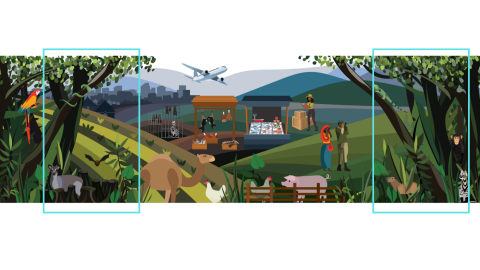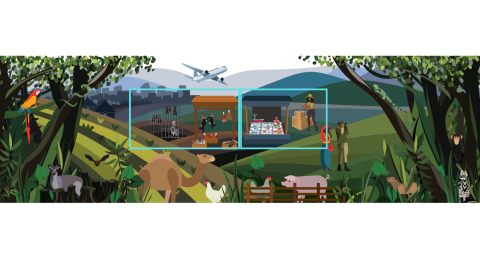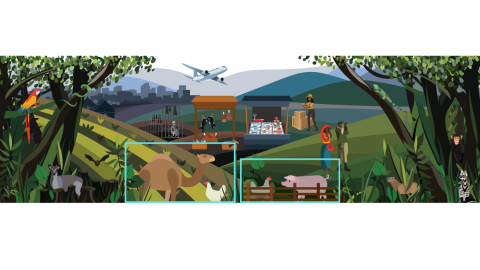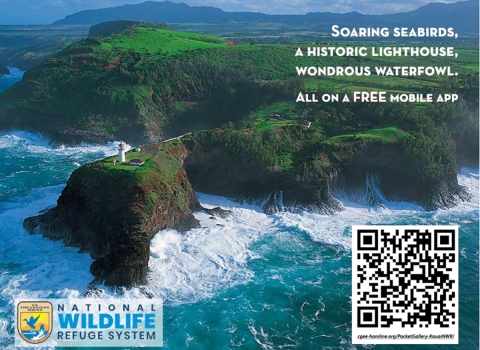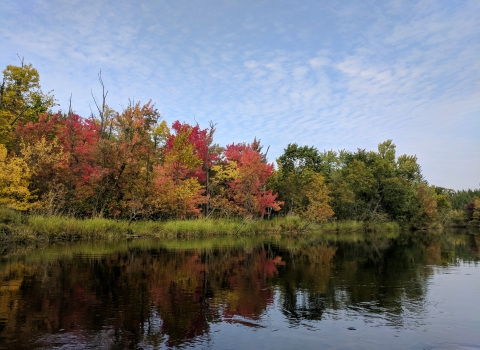Zoonotic diseases - those that spread between animals and humans - have captured the imagination of screenwriters and authors for years: Nipah virus inspired the catastrophic pathogen in the movie Contagion; author Tom Clancy pitted his Jack Ryan character against Ebola; and a policy staffer contracted the Marburg virus during hostage negotiations in an episode of Madam Secretary (he recovered).
Zoonotic diseases have, of course, also caused real-world outbreaks and pandemics with immense impacts on industry, economies, and wildlife and human wellbeing. But these stories, both real and fictional, usually fail to start at the beginning. We know zoonoses originate in animals, but how do they emerge and transmit to humans (a process called spillover)?
To help tell this story of spillover, the U.S. Fish and Wildlife Service's International Affairs (IA) program developed a graphic depicting the factors that increase the risk of disease emergence and transmission and, conversely, countermeasures that can help prevent spillover events. Below is a walkthrough of the graphic detailing these risk factors and countermeasures, the role of wildlife in spillover and spillover prevention, and how the work of the U.S. Fish and Wildlife Service's International Affairs (IA) program helps prevent future outbreaks and pandemics.
Note that the graphic also shows how the health of wildlife and domestic animals, plants, humans, and our shared environment are intrinsically interconnected, a concept known as One Health. A key component of One Health is that what benefits one (either animals, plants, humans, or the environment) benefits and bolsters the health of the others. When wildlife populations are healthy and ecosystems are intact and functioning, they help prevent zoonotic spillover and ultimately protect domestic animal and human health. But let's start at the beginning of the spillover story...
Wildlife & Habitats
Sources: Habitat fragmentation, deforestation, and human encroachment
Habitat fragmentation and deforestation lead to loss of food and shelter resources, thus increasing predation risk for wildlife. These impacts stress wildlife populations and compromise animals' immune responses, raising their risk for infection and causing them to increasingly shed (i.e., release) pathogens into the environment (Ellis et al., 2012; Seltmann et al., 2017). This ultimately threatens the health of individual animals and the health of wildlife populations at large.
Deforestation and fragmentation also push wildlife into new areas and often into closer contact with humans (and vice versa, as humans increasingly encroach on wildlife habitat), increasing the risk for spillover (Mohamed and Wali, 2023).
Safeguards: Intact habitats and healthy wildlife populations
Intact habitats and healthy wildlife populations support ecosystems that are more resilient to disease and other environmental disturbances. Protecting intact habitats also reduces human-wildlife interaction and further reduces the likelihood of spillover.
IA works to protect healthy wildlife populations and habitats around the world. Through its species-focused and regional funds, IA provides financial and technical assistance to partners working on the ground to safeguard healthy wildlife populations and protect functional and resilient ecosystems.
Wildlife Trade & Markets
Sources: Unsanitary markets and unregulated and illegal trade
In markets where live animals are kept in close contact with other wildlife and humans, there is increased risk for spillover and disease spread. Unsanitary conditions, where humans may come into contact with animal bodily fluids or improperly cooked or stored animal products, also increase the risk of spillover.
Unregulated and illegal trade in wildlife also presents a spillover risk. Illegal shipments can bypass disease checks and quarantine requirements. Traders may also transport wildlife in poor conditions (lack of water, restricted movement) that can increase the animals' stress, risk for infection, and pathogen shedding. These factors risk the health of the wildlife, border agents, traders, and other humans involved in the trade route (Hilderink & de Winter, 2021).
Safeguards: Sanitary best practices and regulated, legal trade
Ensuring markets follow best practices for sanitary handling and storage of animals and animal products (refrigeration, gloves) can reduce spillover risk.
Regulating international wildlife trade and working to combat trafficking of animals and animal parts helps 1) ensure that shipments are appropriately screened for diseases, 2) promote transport conditions that are safe for animals and humans, and 3) minimize risky human-wildlife interactions during transit. IA's Combating Wildlife Trafficking Program works to combat the illegal wildlife trade and, through import and export permits, regulates international wildlife trade according to U.S. regulations and requirements under an international treaty called CITES (Convention on International Trade in Endangered Species of Wild Fauna and Flora).
Wildlife-Livestock Interface
Sources: Agricultural encroachment and livestock interactions
The expansion of agricultural operations into habitat can push wildlife into greater contact with livestock (Meurens et al., 2021). This can increase the risk for cross-species disease transmission.
When pathogens are transmitted from wildlife to livestock, infected livestock may serve as bridging hosts by transmitting that pathogen to humans. For example, in Australia, when flying foxes experienced a loss of foraging habitat, they moved closer to agricultural areas. The flying foxes then transmitted Hendra virus to nearby horses, who, acting as a bridging host, transmitted the virus to humans (Peggy et al., 2023).
Safeguards: Biosecurity and wildlife-friendly agriculture
Implementing biosecurity measures on agricultural operations can help reduce the risk for cross-species transmission and spillover via bridging species. Best biosecurity practices include enclosures to keep livestock and wildlife separated, livestock vaccinations, and vector control measures (e.g., mosquito and tick eradication).
IA promotes wildlife-friendly livestock operations through our work with conservation partners. For example, IA's Africa Branch supports research on the impacts of transhumance (i.e., the regular movement of pastoralists and their livestock) in and around high-value conservation areas in Africa's Sudano-Sahel. Our work to protect and promote intact habitats also helps counter fragmentation and human encroachment, reducing the likelihood of risky wildlife-human and wildlife-livestock interactions.
While wildlife is a major source of zoonotic diseases, it is also an inseparable part of the solution. Protecting healthy wildlife populations and intact ecosystems also protects humans (and other animals and ecosystems) from the impacts of spillover. IA's conservation work abroad is the Service's primary frontline defense against future outbreaks, helping to prevent pandemics at the source.
The moral of this story: protecting biodiversity is a critical strategy to prevent spillover and ultimately safeguard animal, human, and environmental health.
Click here for a factsheet on zoonotic spillover!

